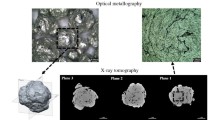Abstract
Periclase powders available from domestic (Magnezit JSC) and foreign manufacturers are analyzed for chemical and mineralogical composition. Domestic magnesite is shown to differ from its foreign analogs in smaller values of MgO content, CaO/SiO2 ratio, and periclase crystal size. A way toward obtaining high-quality powers involves reducing the concentration of SiO2 in magnesite to 0.2 – 0.5% and increasing the calcination temperature to 2000 – 2100°C to prepare coarse-grained periclase with a crystal size larger than 140 μm. The need for developing a technology that would enable fabrication of refractory components with tailored structural properties from periclase powder is emphasized.
Similar content being viewed by others
REFERENCES
I. D. Kashcheev, Oxide-Carbon Refractory Materials [in Russian], Intermet Engineering, Moscow (2000).
A. V. Gal'yanov, Yu. V. Laptev, M. N. Kovalev, and A. I. Vladimirov, “Beneficiation of the mined magnesite ore,” Ogneup. Tekh. Keram., No. 7, 35-37 (2000).
V. N. Koptelov, A. N. Chuklai, Yu. A. Dmitrienko, et al. “Resource-saving technology for production of periclase powders with a 92–95% MgO content,” Ogneup. Tekh. Keram., No. 3, 22-25 (1996).
K. K. Strelov, Yu. M. Galkin, T. S. Ignatova, et al., “Magnesia powders obtained by chemical enrichment of magnesite and their sintering characteristics,” in: Res. Conf. “Magnesia refractories based on treated raw materials,” November 1975. Abstracts [in Russian], Sverdlovsk (1975), pp. 11-12.
I. S. Kainarskii and É. V. Degtyareva, Basic Refractories [in Russian], Metallurgiya, Moscow (1974).
A. V. Kuznetsov and É. A. Shumakher, “Use of different refractories for the lining of a high-power arc furnace,” Stal', No. 1, 29-32 (2000).
A. Ryder, “A new large crystal sintermagnesia,” in: UNITECR'91, Aachen, Germany, 23rd September (1991), pp. 1-12.
A. Ryder and G. F. Quinn, “Investigation of the reactions between ladle slag and sintermagnesia,” in: IREFCON'98, Calcutta, 11–13 February (1998), pp. 1-6.
H. Priemer and G. Mörtl, “High-temperature shaft kiln for large crystal periclase materials,” in: Proc. Int. Symp. Refract.: Refract. Raw Mater. and High Perform., Refract., Prod. Handzhou, Nov. 15–18, 1988, Oxford Inc., Beijing (1989), pp. 167-178.
“Research strategy in ferrous metallurgy,” in: Progress in Ferrous Metallurgy in Russia and Abroad. Appendix, Part II, No. 1 [in Russian], Moscow (2000), pp. 1-54.
I. G. Ochagova, “World production and uses of refractories in steelmaking industry,” in: Progress in Ferrous Metallurgy Abroad. Appendix 6 [in Russian], Moscow (2000), pp. 1-41.
I. D. Kashcheev, “Basic principles of the molding of refractory-based protective coatings,” Ogneupory, No. 3, 5-7 (1991).
I. D. Kashcheev and V. P. Semyannikov, “The role of structural factor in increasing the corrosion resistance of refractories,” Ogneupory, No. 9, 2-4 (1993).
K. K. Strelov, Structure and Properties of Refractory Materials [in Russian], Metallurgiya, Moscow (1982).
I. D. Kashcheev, Corrosion-Resistant Refractory Materials for Steelmaking Industry, Author's Abstract of Doctoral Thesis [in Russian], Ekaterinburg (1996).
V. V. Skorokhod (ed.), Mass-Transfer Processes in Sintering [in Russian], Naukova Dumka, Kiev (1987).
F. F. Lange, “Sinterability of agglomerated powders,” J. Am. Ceram. Soc., 65(12), 199-201 (1982).
K. K. Strelov and I. D. Kashcheev, Theoretical Foundations of the Refractory Materials Engineering [in Russian], Metallurgiya, Moscow (1996).
V. A. Kononov, “The steel casting by use of moving gates,” NTI Byul. Chern. Metall., No. 11, 22-27 (1995).
N. C. Ciocea, V. Bertalan, Fl. Mihalache, and C. R. Barbaresso, “Mullite refractory castables with low and ultralow cement content,” in: Key Engineering Materials. Vols. 132–136, Euro Ceramics V. Part 3. Trans. Tech. Publications, Switzerland (1997), pp. 1806-1809.
Yu. E. Pivinskii, Ceramic Binders and Ceramic Castables [in Russian], Metallurgiya, Moscow (1990).
G. D. Semchenko, Sol-Gel Process in Ceramics Engineering [in Russian], Business Inform JSC, Kharkov (1997).
P. A. Kouzov, Dispersion Analysis of the Composition of Industrial Dust and Ground Materials [in Russian], Khimiya, Leningrad (1987).
I. D. Kashcheev, S. F. Shishkin, K. G. Zemlyanoi, et al., “Grain-size analysis of finely disperse powders by means of a scanning photosedimentograph,” Ogneup. Tekh. Keram., No. 4, 19-22 (1998).
L. M. Aksel'rod, “Refractory castables of a new generation in the production of iron and steel,” Ogneup. Tekh. Keram., No. 8, 35-42 (1999).
L. B. Khoroshavin and V. A. Perepelitsyn, “On the refractory nanotechnology,” Ogneup. Tekh. Keram., No. 12, 30-35 (1999).
N. B. Ur'ev, Physicochemical Foundations of the Technology of Disperse Systems and Materials [in Russian], Khimiya, Moscow (1998).
I. G. Ochagova, “Castable linings for steel-teeming ladles,” in: Progress in Ferrous Metallurgy Abroad). Appendix 6 [in Russian], Moscow (2000), pp. 17-31.
Author information
Authors and Affiliations
Rights and permissions
About this article
Cite this article
Kashcheev, I.D. Ways Toward Improving the Technology of Refractories Based on Powdered Periclase. Refractories and Industrial Ceramics 42, 288–293 (2001). https://doi.org/10.1023/A:1012770513283
Issue Date:
DOI: https://doi.org/10.1023/A:1012770513283



